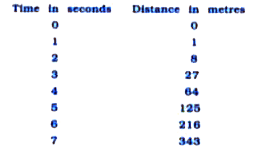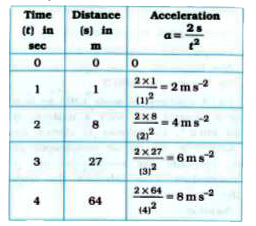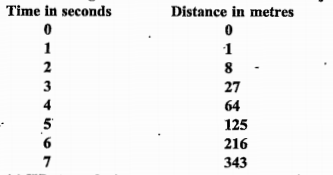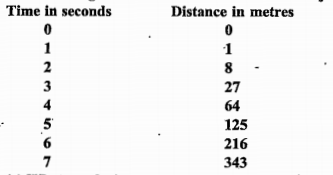The following is the distance-time table of an object in motion:

(a)What conclusion can you draw about the acceleration ?Is it constant. Increasing decreasing ir zero? (b)What do you infer about the force acting on the object?Solution in Gujrati
From the given table,initial speed to the object is zero.
s=ut+12at2
Here,u=0
∴s=12a2
∴a=2st2

(a)From 3rd column of the above table it is clear that the acceleration is increasing uniformly with time.
(b)Force is directly proportional to the acceleration (2nd law of motion)
therefore force acting on the object are increasing uniformly with time.
Topper's Solved these Questions
- BOOK - KUMAR PRAKASHANCHAPTER - FORCE AND LAWS OF MOTIONEXERCISE - Additional Numericals for Practice18videos
FORCE AND LAWS OF MOTION
- BOOK - KUMAR PRAKASHANCHAPTER - FORCE AND LAWS OF MOTIONEXERCISE - Question based on pracctical skill with answers(Select the appropriate option and complete the sentence :)4videos
FORCE AND LAWS OF MOTION
- BOOK - KUMAR PRAKASHANCHAPTER - FORCE AND LAWS OF MOTIONEXERCISE - Additional solved numericals9videos
FORCE AND LAWS OF MOTION
- BOOK - KUMAR PRAKASHANCHAPTER - GRAVITATIONEXERCISE - ACTIVITY 10.42videos
GRAVITATION
Similar Questions
The velocity of an object of mass 50 kg increases from 3 ms−1 to 12 ms−1. What will be the force required for this?
01:28View SolutionNewton's II law of motion connects:
10:20View SolutionA truck starts from rest and rolls down a hill with a constant acceleration .It travels a distance of 400 m in 20 ms.Find its acceleration 6 tones (Hint:1 tonne =1000 kg)
03:45View SolutionTake an empty plastic bottle . Close the mouth of the bottle with an airtight stopper . Put it in a bucket filled with watere . The bottle floats .
Push the bottle into the water. You feel an upward push. Try to push it further down. You will find it difficult to push deeper and deeper. Water exerts a force on the bottle in upward direction. Now release the bottle. It bounces back to the surface.
Does the force due to the gravitational attraction of the earth act on this bottle? If so, why doesn't the bottle stay immersed in water after it is released ?02:27View SolutionWhat can you say about the motion of an object whose distance-time graph is a straight line parallel to the time axis ?
06:31View SolutionThe following is the distance-time table of an object in motion:
Time in secondsDistance in metres001128327464512562167343
(a) What conclusion can you draw about the acceleration? Is it constant, increasing, decreasing, or zero?
(b) What do you infer about the forces acting on the object?06:31View Solutionएक वस्तु की गति कि अवस्था में दूर - समय सारणी निम्नवत है
समय (सेकण्ड)दुरी (मीटर )001128327465512562167343
(a) त्वरण के बारे में आप क्या निष्कर्ष निकाल सकते हैं ? क्या यह नियत है ? बढ़ रहा है ? घाट रहा है ? या शून्य है ?
(b) आप वस्तु पर लगने वाले बल के बारे में क्या निष्कर्ष निकाल सकते हैं ?03:07View SolutionThe following is the distance time table of an object in motion

(a) What conclusion can you draw about the acceleration ? Is it constant increasing , decreasing or zero ?
(b) What do you infer about the forces acting on the object ?03:02View Solutionएक वस्तु की गति की अवस्था में दूरी समय सारणी निम्नवत है

a. त्वरण के बारे में आप क्या निष्कर्ष निकाल सकते हैं? क्या यह नियत है? बढ़ रहा है? घट रहा है? या शून्य है?
b. आप वस्तु पर लगने वाले बल के बारे में क्या निष्कर्ष निकाल सकते हैं?05:16View SolutionThe second-time array in the state of motion of an object is as follows: What can you conclude about acceleration? Is it due Growing up? Or zero?
02:04View SolutionThe second-time array in the state of motion of an object is as follows: What can you conclude about the force exerted on the object?
01:40View SolutionThe following is the distance-time table of an object in motion: What conclusion can you draw about acceleration? Is it constant, increasing deacreasing or zero?
 01:50View Solution
01:50View SolutionThe following is the distance-time table of an object in motion: What do you infer about forces acting on object?
02:11View SolutionThe following is the distance-time table of an object in motion:

What conclusion can you draw about the acceleration? Is ti constant, increasing, decreasing, or zero?02:03View SolutionThe following is the distance-time table of an object in motion:

What do you infer about the forces acting on the object?01:32View Solution

